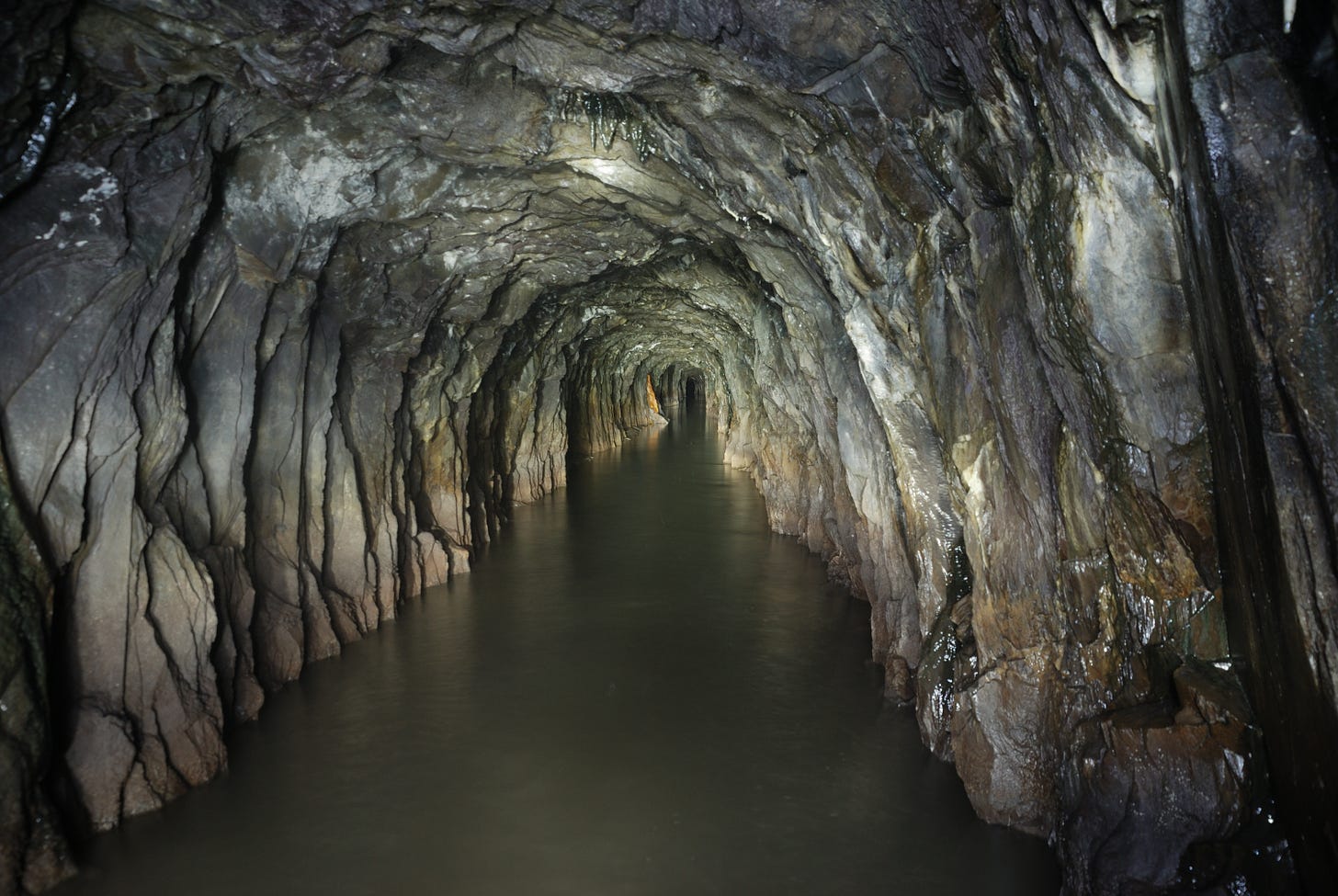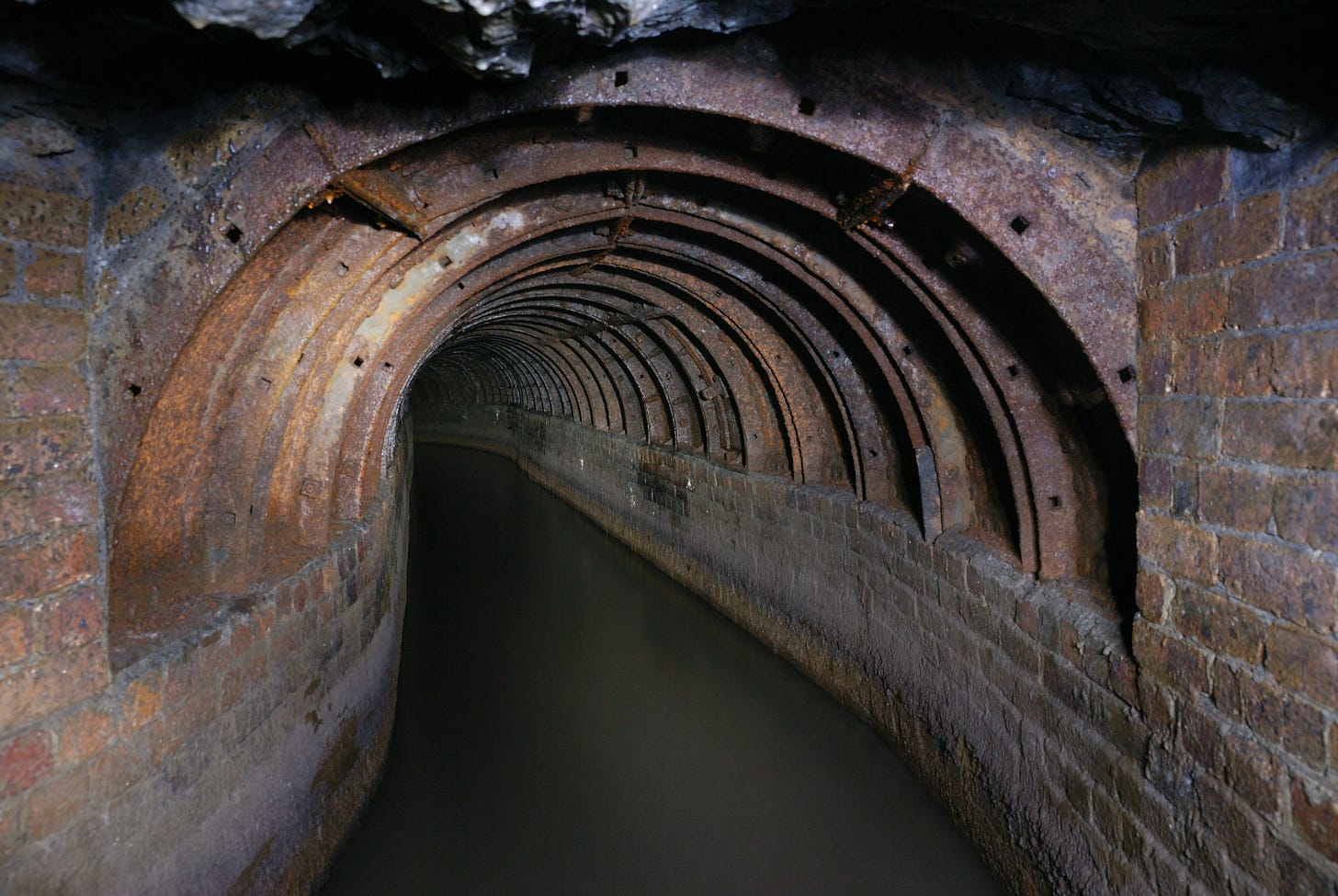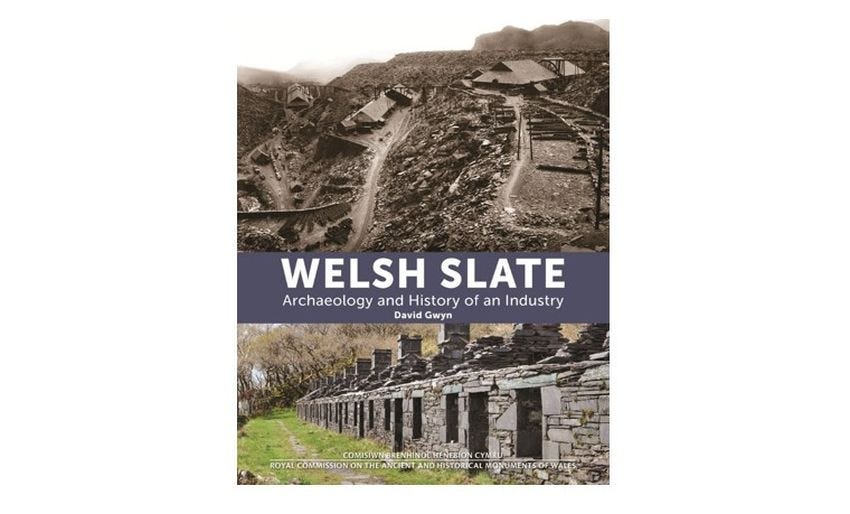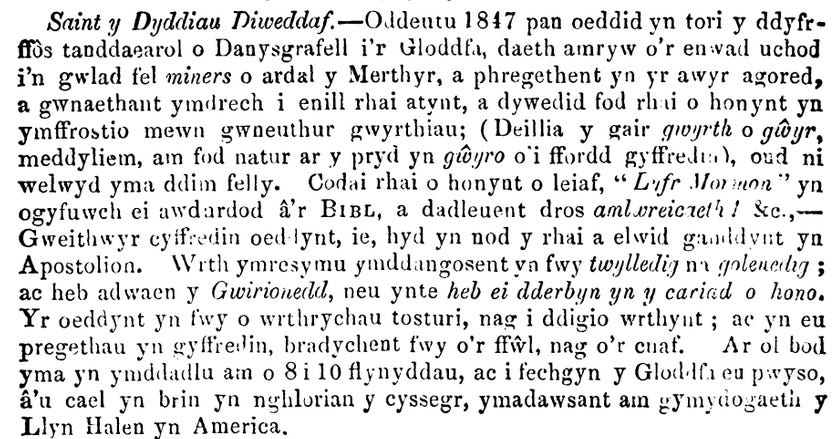The Penrhyn Drainage Adit: Driven by Mormons?
Assessing a claim made in an official history book.
[The following is a part-copy of a document formally submitted in January 2023 to challenge an official assertion about the involvement of Latter Day Saints (‘Mormons’) at the Penrhyn slate quarry]
Leading from amateur survey work in 2021, the claim that ‘Mormons’ (Latter-Day Saints) drove the Penrhyn drainage adit (NPRN 40564, scheduled August 2021) came under examination. We wondered whether this claim was supported by primary sources.

The specific claim made with respect to the drainage adit at page 96 of Welsh Slate – Archaeology and History of an Industry (David Gwyn, 2015, published by RCAHMW) is:
“It was cut by experienced miners from Merthyr Tydfil, who brought their Mormon faith to the Ogwen valley, and who departed for Salt Lake City at the end of the contract.”
An assertion of fact (“it was cut by”) is therefore unambiguously made in this important overall work.
The cited references (Caernarfon Record Office Gwynedd: Penrhyn quarry papers XPQ/997: 20 and XM/Maps/375) within Gwyn’s text had already been examined by us in person. To us, they did not contain information that permitted this definitive link between Mormons and driving the adit to be made.
We therefore asked Dr. Gwyn directly as to what primary source he had in fact relied upon to make this assertion. The response (28/4/2022, 18:43) was as follows:
“The source is Hugh Derfel Hughes, Hynafiaethau Llandegai a Llanllechid (Bethesda, 1866), p. 107
Saint y Dyddiau Diwethaf - Oddeutu 1847 pan oeddid yn torri y ddyfr-ffos tanddaearol o Danysgrafell i'r Gloddfa, daeth amryw o'r enwad uchod i'n gwlad fel miners o ardal y Merthyr .... Ar ol bod yma yn ymddadlu am 8 i 10 flynyddau, ac i fechgyn y Gloddfa eu pwyso, a'u cael yn brin yn nghlorian y cyssregr, ymadawant am gymdogaeth Llyn Halen yn America.
Later-day Saints - About 1847 when the drainage level from Tanysgrafell to the Quarry was driven, many of the above denomination came to our country as miners from the Merthyr area ... After staying here for 8 to 10 years, and being weighed in the balance and found wanting by the quarry lads, they departed for the Lake Salt area of America.
Yours sincerely,
David Gwyn”
The translation by Gwyn of Salt Lake as ‘Lake Salt’ is curious, and clearly in error.
We were already familiar with the reference by Hugh Derfel Hughes, it being readily available online, at https://babel.hathitrust.org/cgi/pt?id=hvd.hxdcfw&view=1up&seq=7
The full Hughes (1866) text referred to by Gwyn is as follows:
Although translation ought not to be necessary for research within Wales, we provide such, with an emphasis on retaining meaning (and emphases) in the original, for the benefit of those without facility in the language:
Latter Day Saints. - About 1847 when the underground drainage ditch [drainage adit] was being cut from Tanysgrafell to the quarry, several of the above denomination came to our realm as miners from the area of Merthyr, and they preached in the open air, and they strove to win over others to them, and it was said that some of them boasted of doing miracles; ( The word gwyrth derives from gŵyr, we think, because nature does gŵyro [deviates] from its ordinary way), but nothing of the kind was seen here. A few of them, at least, held "The Book of Mormon" to be equal in its authority to the Bible, and they argued in favour of polygamy! &c, Yes, they were common workers, even those they called Apostles. In reasoning, they appeared more deceptive than enlightening; and without knowing the Truth, or otherwise had not received it [the Truth] from a love of it. They were more the objects of pity than the kind with whom one could be displeased; and in their sermons in general, they betrayed more of the fool, than of the rogue. After being here debating for 8 to 10 years, and the lads of the quarry had weighed them, and found them wanting on the balance of sacred devotion, they left for the area of Salt Lake in America.
Comment.
[Dr. Gwyn was given the opportunity to respond to this analysis in October 2022. At the time of issue (early March, 2023), no such response has been received. We would be pleased to include any response he may subsequently wish to make].
We cannot agree with Dr. Gwyn that the 1866 Hughes reference, in and of itself asserts as fact, or even permits a reasonably reliable inference to be made, that the drainage adit was driven by Mormons, for the following reasons:
(1) Hughes does not assert that Mormons came to Penrhyn quarry to drive the drainage adit; he merely correlates – and only approximately (“oddeutu [about] 1847”) – their arrival with “pan oeddid [when] the underground drainage ditch was being cut” [my emphasis]. Whilst is is possible the Mormons did arrive to drive the adit, there is no reliable assertion of fact in this source – published some 16 years after completion of the adit – that they did so. Indeed, the “pan oeddid” suggests the adit driving was already underway when the Mormons arrived, although that does not preclude their possible subsequent contribution to the driving.
(2) No names of workers are provided that would then permit examination of primary sources such as employment/pay records. Whilst Mormons, at least one of whom, David Williams (see details below) was a prominent Elder, were present in and around Bethesda, and gave his occupation whilst there as ‘miner’ (Census of 1851, see notes, below) there is no primary material that links them to the adit driving specifically nor, indeed, is there any reference to slate, slate quarrying or Penrhyn; Williams could just as easily have been temporarily unemployed but considered himself a miner until recently (and would be again, in the US).
(3) The Mormons are said to arrive in the area (“gwlad”) as “miners”; no mention of Penrhyn or the quarry is directly made. “Miners” is a broad term – Bethesda men would normally say they were ‘quarrymen’ – that could mean anything from extracting slate at the galleries to driving gallery-to-hydraulic shaft adits (or shafts themselves) and short tunnels through dykes – or driving the drainage adit; no information guides us, either way. Or we could simply take the statement literally: they arrived as miners from Merthyr; what they then did at the quarry, if that is indeed where they worked, is unstated.
(4) We consulted in detail with the Latter Day Saints in the US on this matter. The LDS community places very considerable importance on their ancestors which, in itself, is a very good reason to ensure assertions about such ancestors are not based on weak or absent evidence. We encourage interested readers to consult, for example,
http://www.welshsaints.byu.edu/
We began with that resource ourselves, and came into direct correspondence with Dr. Ronald Dennis of Brigham Young University and, subsequently, other leading US-based LDS family history researchers. Despite this collaboration on the famously-meticulous LDS archives, no reliable link between any identified Mormon in Bethesda and driving the Penrhyn drainage adit could be found.

Conclusion.
At the time of writing, therefore, the 1866 Hughes reference clearly makes no assertion of fact of a link between Mormons and the driving of the drainage adit, other than that they arrived “at the time” of the adit driving. Gwyn makes a leap, without reliable evidence, to assert the adit “was cut” by Mormons. On close examination of the LDS archives, as well as our local records, no reliable link between Mormons and driving the drainage adit was found, nor was a direct link to the quarry found.
We therefore say that Gwyn’s assertion that the drainage adit was driven by Mormons, whilst of course possibly and even perhaps likely true, is not remotely reliably demonstrated as such, and should not be repeated in the Historic Environment Records. It is our clear understanding that the LDS community in the US, having examined our and their own documents, agree with this conclusion.
Additional Information.
This evidence (or lack thereof) has been deposited with the Gwynedd Archaeological Trust.
The following is a record of David Williams, who converted to Mormonism in 1847 and lived in Bethesda. Given the date, and his later, very strong links with coal mining (highlighted in the record below), this provides the best, albeit still only circumstantial support for Hughes’ references to men of the Mormon faith arriving in north Wales “as miners” from Merthyr, a notable coal mining area.
Name: David Williams
Gender: Male
Relationship to Primary Person: Self (Head)
Father: David Williams
Mother: Sarah Reese
Birth Date: 16 Dec 1827
Birth Place: Monmouthshire, Wales
Death Date: 6 Dec 1889
Death Place: Price, Carbon, Utah, USA
Burial Place: Salt Lake City, Salt Lake, Utah, USA
Residences: St. Louis, St. Louis, Missouri, USA
LDS Church Ordinance Data: Baptism Date: August 1846 Baptism Date: 1847 Rebaptism Date: January 8, 1876 Ordained Teacher Date: 1847 Ordained Priest Ordained Elder Date: 1849
LDS Temple Ordinance Data: Endowment Date: January 24, 1878 Sealed to Spouse Date: April 29, 1885
Vocations: Businessman
Comments: David was the first bishop of the Pleasant Valley Utah ward. He became a convert to Mormonism in 1847 and was soon afterwards ordained to the priesthood offices.
He was called to the ministry and traveled as a local missionary for four years, principally in North Wales, with marked zeal and success.
He married Miss Sarah Williams in 1847 and then emigrated to St. Louis, Missouri in 1855, being president of the Welsh Saints who constituted a large part of the company on the trip.
After remaining at St. Louis about one year, he went to Kingston, Illinois and located more permanently at Canton, Illinois in 1856.
At this time he was in very poor circumstances financially, but he went to work with a will as a coal miner and was successful.
After a while he purchased a tract of coal land in the town of Canton, which subsequently became valuable property. He also acquired two other tracts of coal land near the same town.
In November 1875, Elder Benjamin F. Cummings, Junior who at that time traveled as a missionary in Illinois met him and revived his interest and faith in Mormonism and at his request he was rebaptized.
He immediately took an active part in extending missionary work in Canton and the vicinity and owning to the facilities which Brother Williams had for furnishing employment, a number of scattered saints gathered into Canton, where a branch of about fifty members soon sprang up with Brother Williams as president.
At the opening of the year 1876 he was a wealthy man, using his means generously to forward the work of the Lord, but business reverses overtook him in rapid succession and in a short time he was left with only a little means.
Still with his scanty funds he generously assisted a score of members of the Church to emigrate to Utah, where he himself wended his way, arriving at Ogden, August 5, 1877. A few days later he landed in Salt Lake City without a dollar, but he and his family were happy and cheerful.
He began the business of a retail coal dealer in a small way and was again successful. In 1878 he filled a short mission to the Southern states. He was an excellent geologist and an experienced coal operator.
Soon after his return from his mission he became a contractor of the D. & R. G. coal mines at Pleasant Valley. The mines were rapidly developed under his control and soon quite a community of miners and their families were gathered in Pleasant Valley. Many of these being Latter-day Saints, a branch of the Church was organized, of which he was made president. In 1883 the Pleasant Valley Ward was organized, he being ordained a bishop and set apart to preside over it. He presided in Pleasant Valley as Bishop until December 1885 when he was called on a mission to Wales.
After laboring a short time as traveling Elder he became president of the Welsh conference with an energetic corps of missionaries under him. During his administration the conference assumed an activity which it had not known for many years.
He spent his own money freely to forward the good cause and labored with great zeal and energy. During his presidency in Wales, the Jarman excitement prevailed in that country. Brother Williams was repeatedly surrounded by howling mobs, who apparently thirsted for his blood, but physical fear was an emotion unknown to him and he never shrank from either danger or duty.
During his three year mission the asthma, a disease from which he had long suffered more or less, became deeply seated and he never obtained relief from it. He returned to Utah in November, 1888, but though broken down in health he could not stand inactivity; hence, in May, 1889, he opened a general mercantile business at Price, Emery, Utah. From that time until his death he suffered terribly at frequent intervals.
He passed away like a child falling to sleep on December 6, 1889 at Price. At the time of his demise a long obituary was published in the "Deseret News", from which the following is extracted:
“Brother Williams was a good and a remarkable man. He was a natural leader, and gifted with rare abilities in some directions. To look into his clear, blue, earnest eyes and doubt his honesty, was impossible. He decided the most important matters instantly, and was generally guided by a correct intuition. In his business plans and enterprises it was nearly always a leading object to provide employment or aid for others, and he has planned for and helped to feed thousands. In gratitude, which is so often the reward of the philanthropic worker, never swerved him from his purpose to labor for the welfare of others. He was a father to his employees. As a parent he was solicitious for and devotedly attached to his children.”




